Here, we will walk you through the course-building process of the Academy LMS plugin. From this section, you will learn about the basic course-building process and also be able to build a full course. Ultimately, the course-building process will become easy peasy for you.
Add a New Course #
To learn about how to create course, let’s head to your WordPress website’s dashboard. Simply log in to your WordPress site through the admin area and click the Academy LMS plugin.
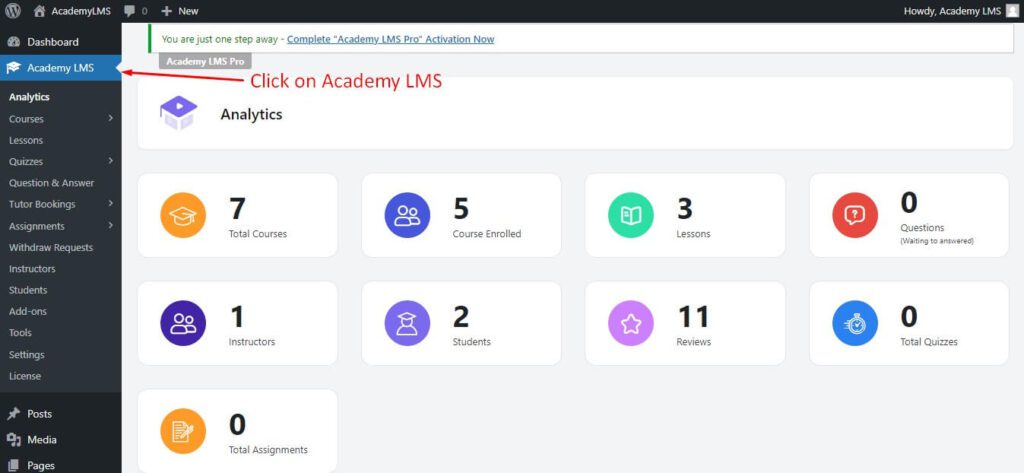
Now, click on Course then Add New Course and explore the user interface. Here, you can Add New Course by adding the Course Title, Description / Content, Adding New Topic, and configuring the Course Settings.
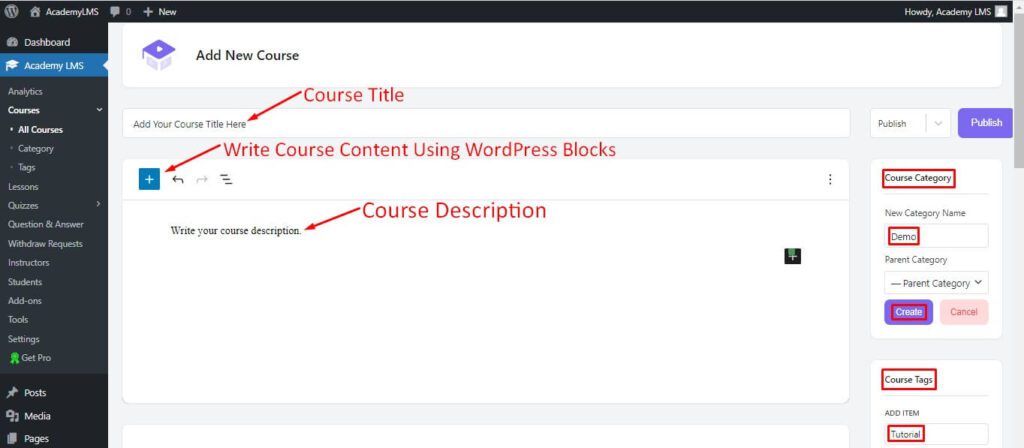
First, Add the Course title by simply putting the title in the course title text box indicated in the image. Then you can move on to the Course description or Content in the text area pointed in the image below. For a description or content area, you will get an editor with options to change the style and alignment and apply more changes to your text, just like the WordPress editor.
On the right-hand side, there is a heading called Course Category. Here, you can add a crouse category name according to your preference. We’ve named the category “Demo.”
Just below the Course category option, there is a section called Course Tags, where you can set the course tags as you wish. We’ve put in the “tutorial” as the course tag.
The next stop is the Course Image section, where you can simply click the Set Featured Image button and add the Featured image for your Course. Look at the example below where we’ve selected an image for our course.
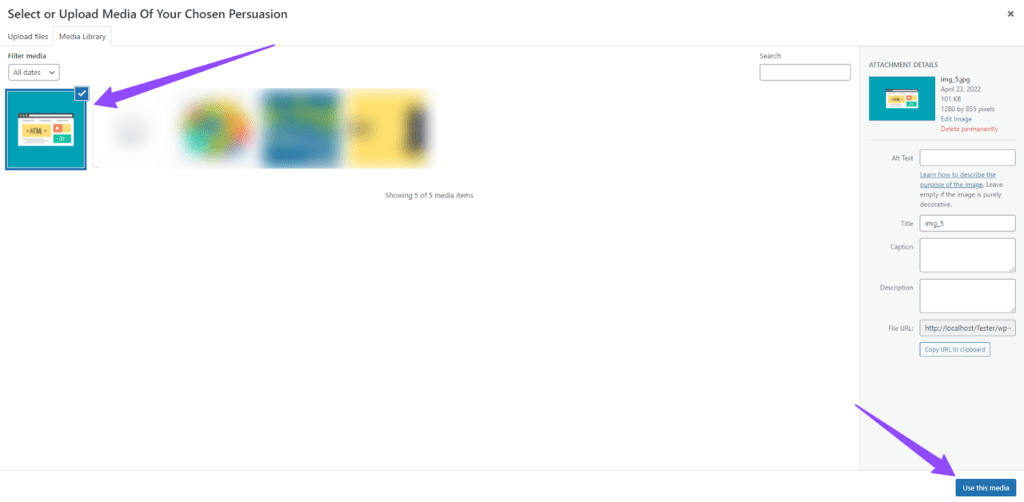
Scroll down a bit to get the other options of the Course Builder. You will see the Excerpt section, where you can put in any excerpt text that you wish.
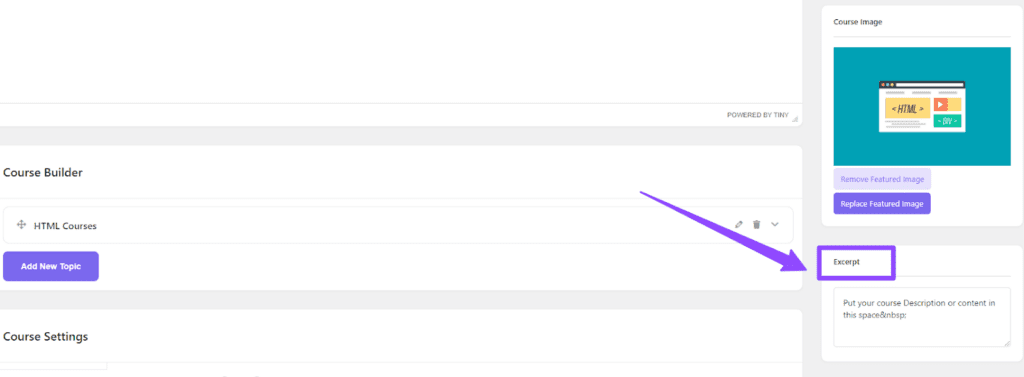
Now that we have the basic settings ready for our course builder, you can scroll up and publish the course.

Right after clicking the publish button, a permalink will be available. You can click the permalink to view the course structure in detail.
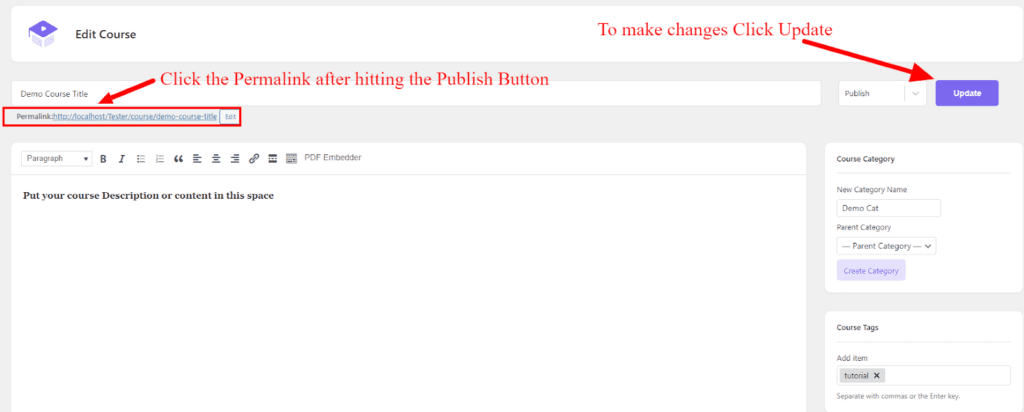
Here is the detailed view of the Course that we’ve built with some basic settings, including Course Title, Description, Category, Tag, and Featured Image.
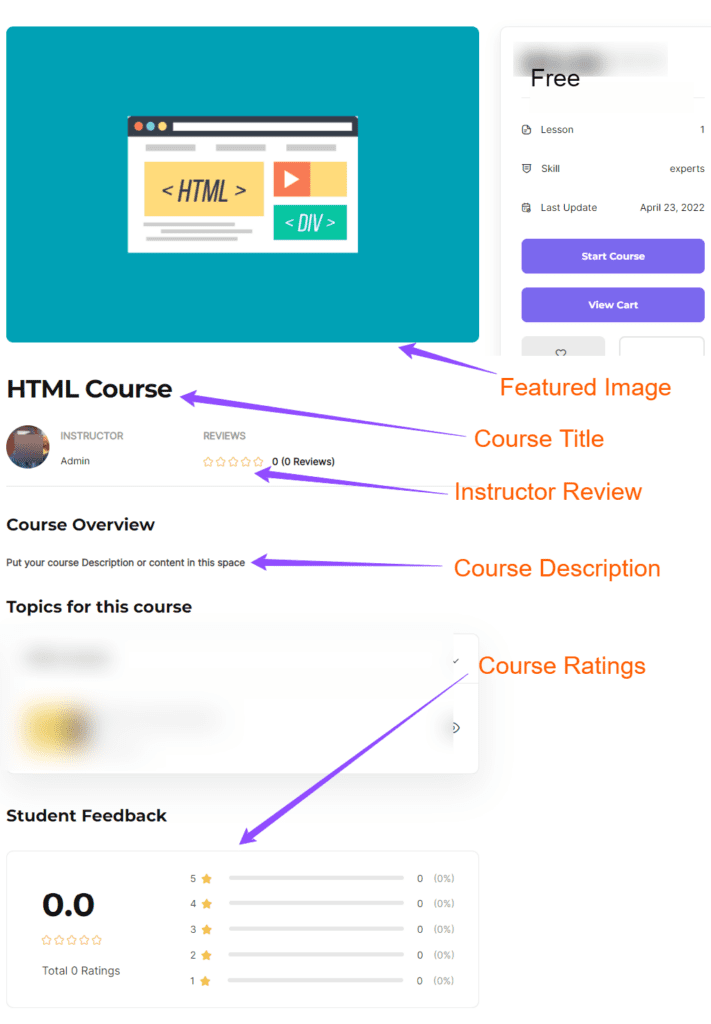
Add a Lesson to the Course #
So as you can see in basic settings, the course description or content is there. But to add lessons and complete the further settings, we have to configure the Course Builder Option.

Now under the Course Builder section, click Add New Curriculum button. A window will appear that will require you to provide the Curriculum Name and Curriculum Summary.

So, after providing the topic name and summary, simply click on the Add Curriculum Button to view the Topic that you just added. As you can see In the following image, two buttons – Add New Lesson & Add Existing Lesson– appear after adding the course.
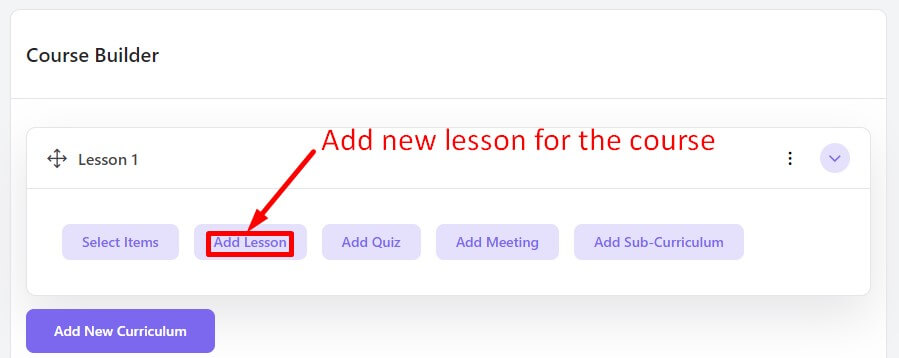
Now, click the Add New Lesson button to add a new lesson for the course (HTML5) that we just created. In Add New Lesson section, input the Lesson Title, Description, and Featured Image.
Note: You can easily reassign or reuse your previously cratered lesson.
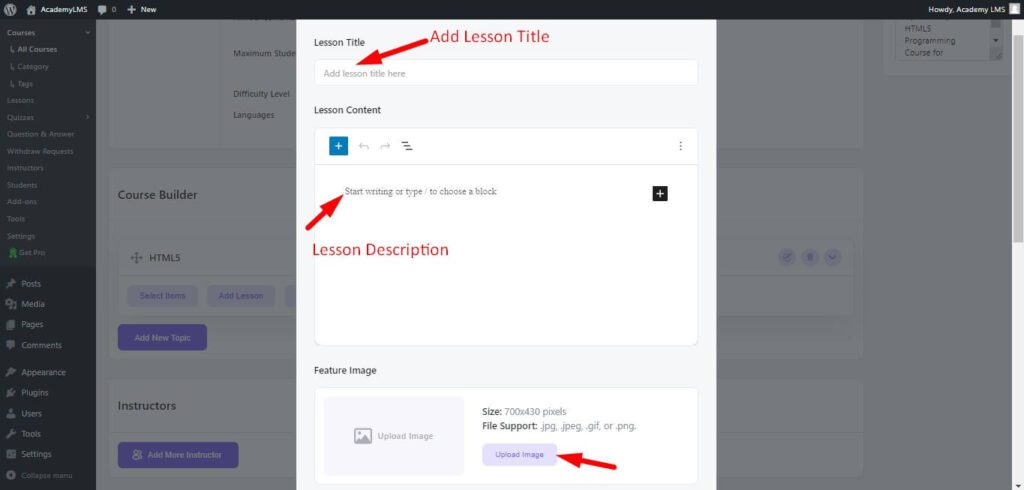
Now, scroll down in the Add New Lesson section to see the other available Lesson Settings.
You can checkmark the Preview Lesson option to make the lesson available for registered and non-registered users. But if you keep it blank, the course will be available only for registered users.
You can select between YouTube, Vimeo, External URL, Embedded, and MP4 for the Video Source option.
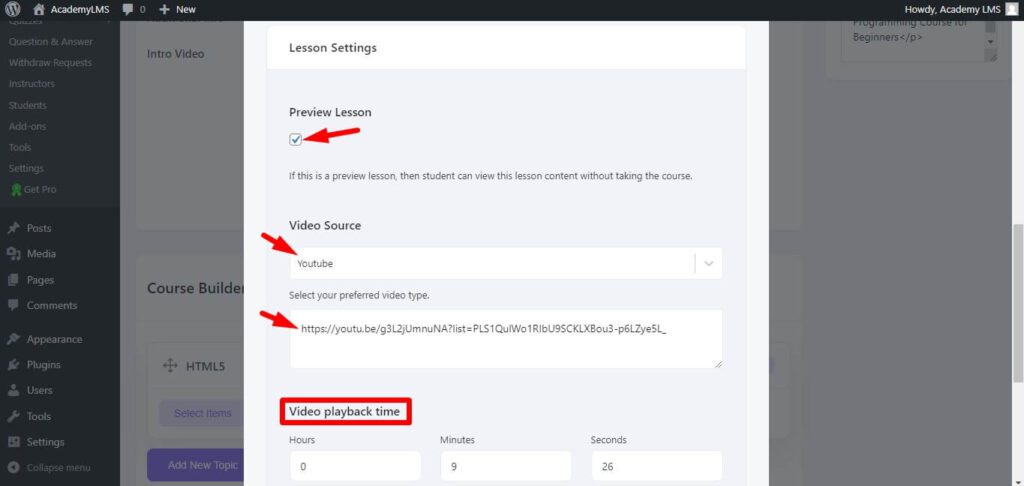
Since we’ve selected YouTube for the Video Source option, we’ve provided a link to the video. Then you can select the Video playback time for this lesson.

Lastly, you can upload any attachment (Notes, Course Instructions, Suggestions, etc.) but clicking the Upload Attachment button.
When you are done configuring your lesson, simply click on the Add Lesson button and your lesson will be created.
You can now see the courses that we’ve just created by clicking the All Lesson option of the Academy LMS plugin. You can even create a new lesson from this section by clicking the Add New Lesson button following the same process.
To clarify, if you create a lesson in a course builder, you may attach that course to any lesson you choose. So, users can create a new lesson, then click add a new lesson, assign it to their Prefered course. They can follow the same process to create and assign lessons.
For example, you’ve created an HTML Course and lessons named Beginners and Advanced lessons. Also, if you’ve created another course named Fundamental of Web Development course, you can assign the same lessons (Beginner/ Advanced) in that lesson.

If you want to view the course, go to the All Courses, then you will be able to view the course you just created. Then click the View option to get a detailed view of the course.

Here is the detailed view of the course where you can see the course details along with the Lesson that we created. So, just below the course name, you will be able to view the Lesson details, including the Lesson name, Featured image, and Lesson Duration.
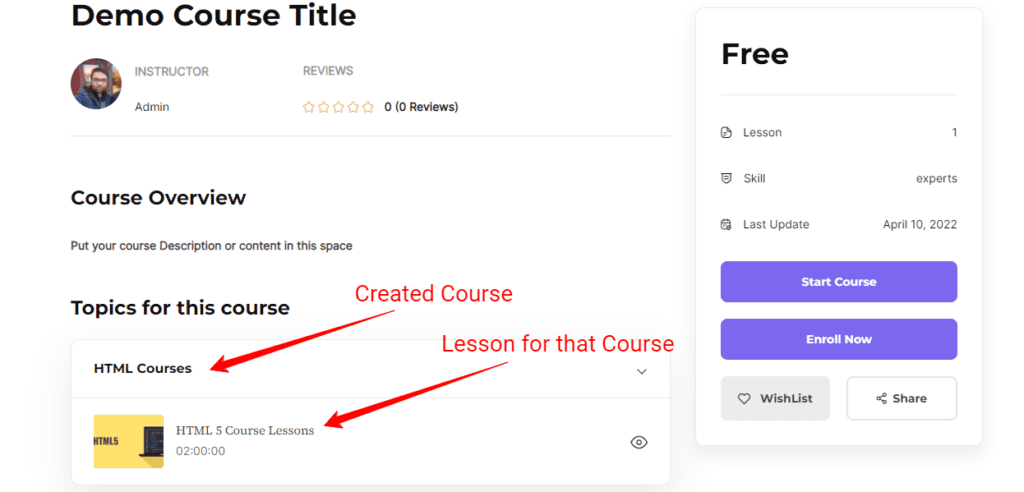
Sub-Curriculum Add #
A sub-curriculum is essentially a smaller curriculum within a larger curriculum. It’s like a chapter within a book, or a specific module within a broader course. It focuses on a particular area of study or skill development that falls under the umbrella of the main curriculum.
To add a sub-curriculum, go to the course builder, then click on Sub-Curriculum.
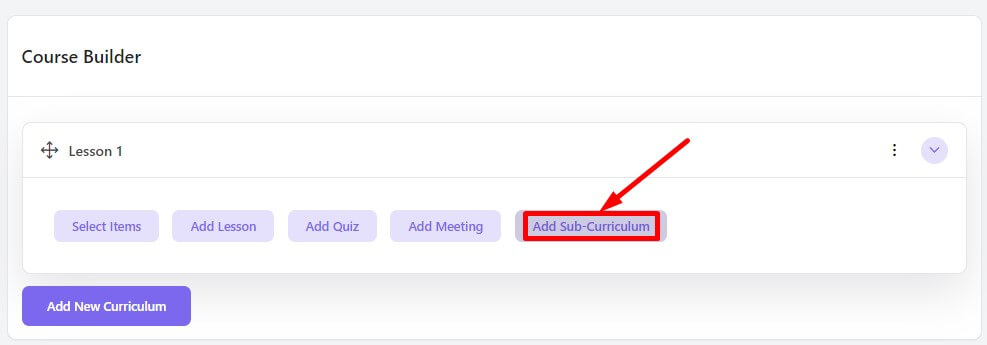
Now set the name for your sub-curriculum, sub-curriculum summary, and lastly click on Add button.
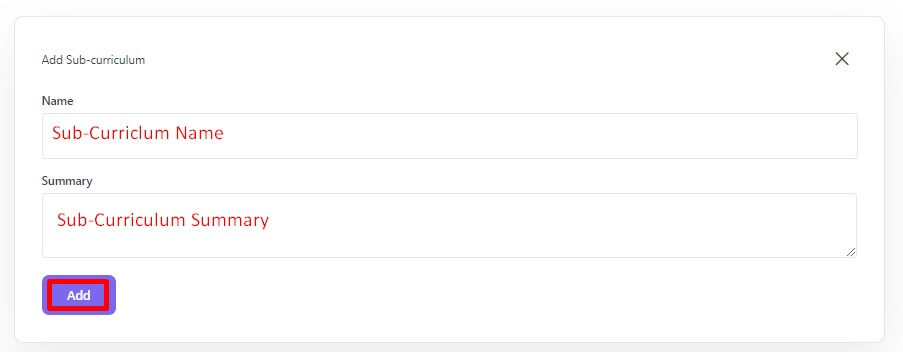
Now you can see a sub-curriculum has been added in the course builder. From here, you can add lessons, quizzes, and other course content for the sub-curriculum.
Course Builder Settings #
Now that you know about adding Courses, let’s start adding some configurations or personalize the settings for the previously created courses. Now that you’ve learned how to build Courses, it’s time to start adding configurations or personalizing the settings for the already created courses.
Start by clicking the All Courses > View. Then scroll down a bit to see the Course Settings.
General Settings #

You can create two types of courses in course settings – (1) Free and (2) Paid Courses.
By default, any course you create will be considered a Free Course. But to create a Paid course, you need to install the WooCommerce Plugin.

Next comes Course settings options. Here you can enable Public Couse, Q&A, and Announcements section. Then Maximum Students Number, where you can mention the highest number of students you are accepting for this course. As you can see, we’ve entered 5 so, only 5 students can take part in this course.

Then in Students Enrolled, you can set the number of students that can enroll in this course. You can set any number, but keep in mind that you can set how many students can join the course (Previous Option: Maximum Students ) even if they’ve enrolled in the previous option.
According to the course’s difficulty level, select an option between Beginner, Intermediate, or Expert. This information will be shown when you will go to the course details.
The next option is Language, where you can mention the language of the course. Simply mention the language by typing in the language name in the box.
Additional Info #

After General Course settings, let’s explore the Additional Info. First of all, you can set the Duration of the course. We’ve set 8 hours as the duration of this course.
Then comes the Benefits of the course where you can mention all the benefits of this course. This helps students/users learn the benefits of the course they want to take.
In the Targeted Audience section, you can specify the audience category of students who will benefit the most from this course.
The next step is to fill out the Requirements section, where you’ll enter the course’s minimal or eligibility requirements (if there are any).
Lastly, you can include the course materials or the list of assets in the Materials Included section.
Intro Video #
Let’s head to the Intro Video section. In Couse Intro Videos, you will get several options in the dropdown menu. You need to provide the URL for YouTube, Vimeo, External, and Embedded options, but you can also upload videos for the course.
Important Note: If you add an intro video to a course, your course feature image will hide automatically.

Paid Course Creation #
Of course, the Academy LMS plugin enables users to create paid courses. Since a significant amount of effort and time is needed to create a course effectively, offering paid courses becomes mandatory. So this section will discuss how to create a paid course via the Academy LMS plugin.
WooCommerce Installation #
First of all, you will need to install the WooCommerce plugin in your WordPress dashboard. Simply click the Plugins and type in WooCommerce in the search bar in the right corner of your screen. Then click enter to view the plugin and then click Install now. After the installation process, activate the plugin to get it inside the WordPress dashboard.
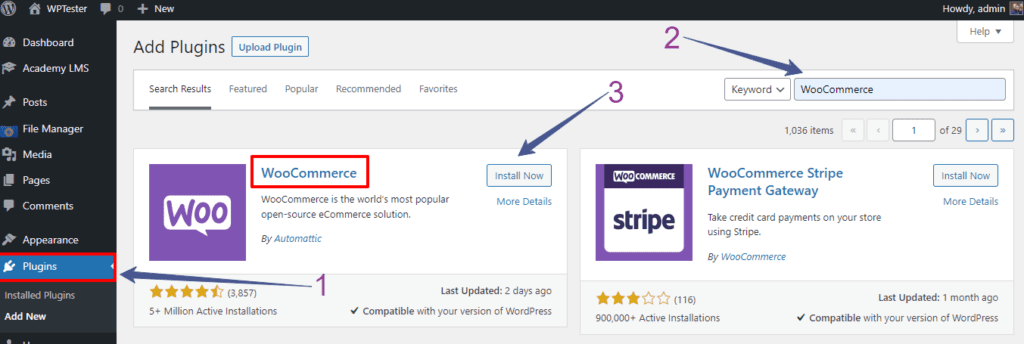
Create a Product In WooCommerce #
Let’s click WooCommerce > Products and create a product in WooCommerce. We will be adding a new product, so you can click Add New or Create Product.

Now set your course name in add new product section. We’ve set the product name as an HTML course. Then scroll down a bit to set up the rest of the settings.
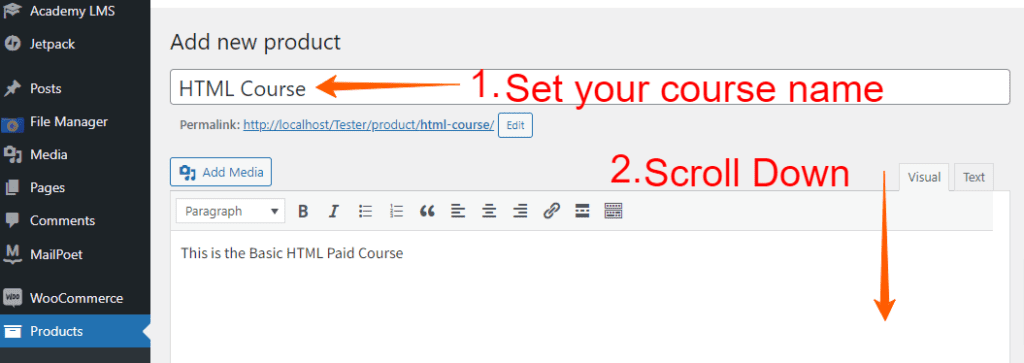
In this section, you can set the regular price and the sale price of your course. You can set the rest of the settings as you prefer since there isn’t any major dependency. But keep in mind that you need to checkmark a box located beside the text saying For Academy LMS. Even if you forget to put the checkmark, the Academy LMS plugin will set it automatically.

When you are done with the settings, scroll up and click Publish. Now your product is ready in WooCommerce.

Relating WooCommerce Product and Academy LMS #
Head back to your Academy LMS plugin and click All Courses. You will be able to view all courses in this section, where you can select any course that you prefer. We are selecting the HTML Course by clicking the Edit button.
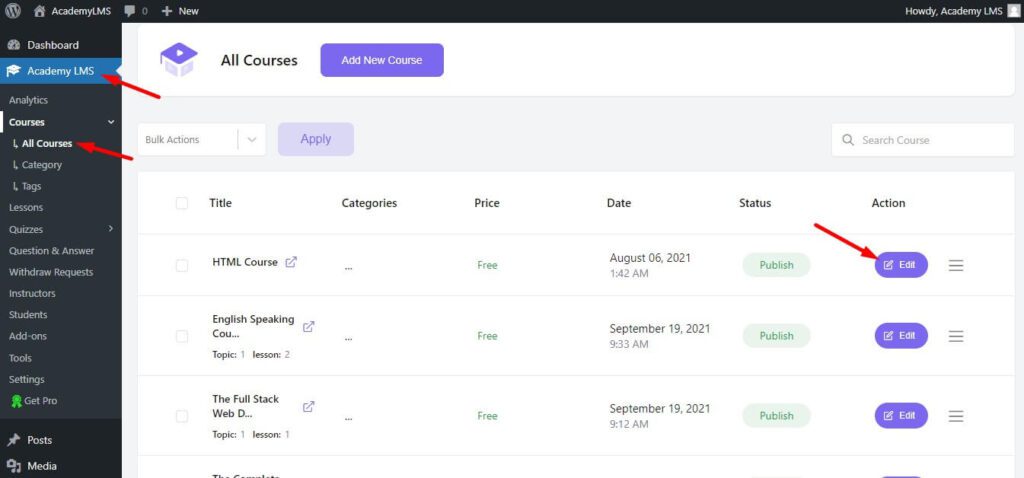
After heading into the course details area, click the Paid option. Then in the select product option, you will be able to view the product HTML Course, which we’ve created previously in the WooCommerce Product creation area.
You can create as many paid products as you prefer, and it will be represented in the dropdown option of the Select Product section. Clic on Paid set and your WooCommerce product or courser that you’ve created will be shown here.

Now scroll up a bit and click the Update button to save the recent changes in this course. When the update process is finished, simply click the link located on the left side of the UI to view the course.

View Course #
While viewing the course, In the course details area, you can see the pricing details, including the previous price and discounted price. We’ve made these settings in the WooCommerce Product settings area.
Also, you will get an Add to Cart button that comes with all the cart functionality and checkout process that are typically offered by WooCommerce. So, WooCommerce will handle all the product and cart-related functionality.

You can click Add to Cart button to explore this WooCommerce feature in detail. After clicking the Add to Cart Button, you will be shown a message (Indicated in the image) on the same page.
The Add to Cart button is now changed to the View Cart button since you’ve added the product to your cart. Click the View Cart button to proceed to the checkout process.

After clicking the View Cart button, you will be redirected to the checkout process of WooCommerce. Users can click the Proceed to Checkout button to complete the purchase process of their selected course.

The checkout page is a typical WooCommerce checkout page where you need to place your Billing information and then place an order to finalize the process.

Now, Head to the WooCommerce > Orders and view the placed order whenever a customer purchases a course. From the Settings option of WooCommerce, you can set whether you want to approve a course instantly or wait for approval from the admin. When approved, students will be able to access the course.

So that’s it! This is how you can easily set up paid courses in Academy LMS. Following the above mentioned process, You may now add paid courses that students can purchase after adding them to their cart and paying for them.
Disclaimer for WooCommerce Settings #
For Academy LMS users who sell their online courses with Academy LMS, here are some settings for you to modify.
Guest Checkout Section:
1st option does not check to mark it: This option allows customers to complete a purchase without creating an account. They will only be asked to provide their billing and shipping information and payment details.
2nd option, check it: This option requires customers to create an account before they can complete a purchase.
Account Creation Section:
Put a checkmark next to it: “Allow customers to create an account during checkout.” This option allows them to create an account while checking out. This can be useful for customers who want to save their information for future purchases.
By configuring this setting, Academy LMS will force students to log in to buy a course, and if you do not configure this setting, then students who buy a course will not get access to the course.







